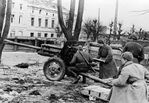Great War (Vasarden)
This article is incomplete because it is pending further input from participants, or it is a work-in-progress by one author. Please comment on this article's talk page to share your input, comments and questions. Note: To contribute to this article, you may need to seek help from the author(s) of this page. |
The Great War, also known in Vierz-speaking countries as the World War (Weltkrieg), was a global war fought between 1942 and 1947. The conflict was largely fought between the Socialist Internationale, led by Luepola, Granzery and Apelia, and the Allied Powers, led by the Vierz Empire, Vonzumier, Tierada, and Savland. The war resulted in the mobilization of some 90 million military personnel in over 20 countries, marking the formation of a state of total war. It is estimated that between 70 to 80 million people died, making it the deadliest war in human history. The war saw the mass deployment of chemical weapons on nearly all fronts and untold numbers of civilian deaths as a result of widespread starvation, disease, and strategic bombing.
Background
Roughly four decades prior, the world's first Flecquist government came to power in Luepola under the leadership of Lev Gincburg. The transition to Flecquism came in the wake of the Industrial Revolution, which especially in Luepola had drastically worsened income disparity. Though in practice it maintained its west Oridian colonies as socialist client states, Gincburg adopted a notably anti-colonial stance in foreign policy, alienating many Patyrian nations who held their own colonial empires.
By 1917, Flecquist sentiments had taken root in many other Patyrian countries, partly through Luepolan influence under Gincburg's successor, Stanislav Kolar. Socialist parties were active and relatively influential in most countries; in Vierzland, Lars Hencke took power in 1927 and ruled shortly before being overthrown by the Vierz military in the June Putsch, and in Apelia, socialist candidate Abel Mallaire was elected, and quickly consolidated authority around himself. Socialists in Vonzumier were among the pro-war advocates in the prelude to the Frontier War with Vierzland. In other countries, such as Granzery and Poicary, communists instigated violent uprisings to install themselves in power. By 1934, Apelia, Granzery, Luepola and the Aitic Union were all governed by Flecquists, and banded together as an economic bloc and military alliance, known as the Socialist Internationale. Though the Aitic Union would leave the bloc in the late 1930s, Apelian and Luepolan colonial holdings in Bhasar and West Oridia made the bloc a formidable force on the world stage. After the death of Kolar, Anton Marusić became the new leader of Luepola, and pursued a policy of direct, aggressive expansion of the SI, helping transform neighboring Vorochia into a socialist state and pressuring Simora to do the same. By 1936, most Patyrian states, as well as larger Artalian states such as Vonzumier, Cape Ark, Hevatia and Aranquia, had all begun arming in anticipation of a significant conflict.
In addition to the rise of Flecquism, various other factors led to the rivalries that would boil over into war. The June Putsch gave rise to a military dictatorship under Vierz general Hermann Eschau, sanctioned by Victor II, who aggressively stamped out socialist influences in the country and pursued a confrontational foreign policy against Luepola and its socialist allies. In Vyzinia, Tarchist leader Stojan Wójcik forced the abdication of Piotr III and aligned his nation with Vierzland, in opposition to Luepola and its socialist influence. Furthermore, numerous territorial and colonial disputes lingered from the times of the Caberran Wars, such as between Luepola and Cestros over Poniscia, Apelia and Tierada over colonies in the Amplian Ocean, and Granzerian claims to territories in southeast Patyria. Vierz public opinion of Luepola was at a record low due to their role in the June Putsch, and opinion of Apelia was similarly low for their role in the Frontier War. Tieradan and Vonzumieran opinion of Apelia similarly dropped in response to Apelia's crushing of the independence movement in Diarusia. Separatist sentiments ran high in northern Granzery (in modern-day Lairea) among ethnic Laireans, with support from the Lairean community in Vierzland.
In July 1940, Zacotian revolutionary Stipo Sevšek assumed control over Zacotia, beginning a sweeping and bloody purge of all known political dissidents. The impact caused a refugee crisis in Yugaria, Simora, and Cestros, with thousands fleeing Zacotia to avoid persecution. By August of 1942, the military of Zacotia arrested Sevšek and removed him from power, summarily executing him shortly after. Simultaneously, Marusić delivered an ultimatum to the Zacotian provisional government to restore Sevšek to power; upon learning of Sevšek's death, he authorized the start of Luepolan military intervention in Zacotia.
The development of the arms and tactics that would lead up to the war was influenced primarily by the Frontier War and the Zaihanese Civil War, the latter of which had begun fifteen years prior and continued through the start of the Great War.





